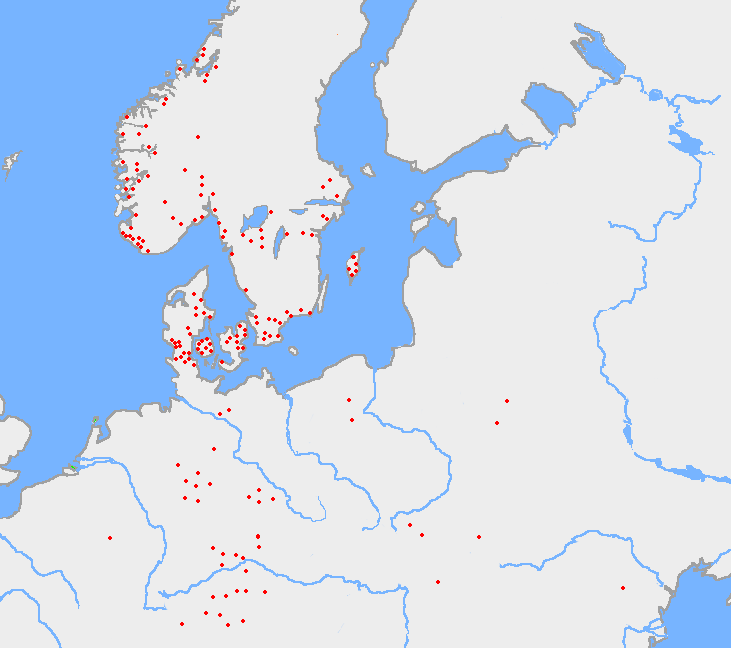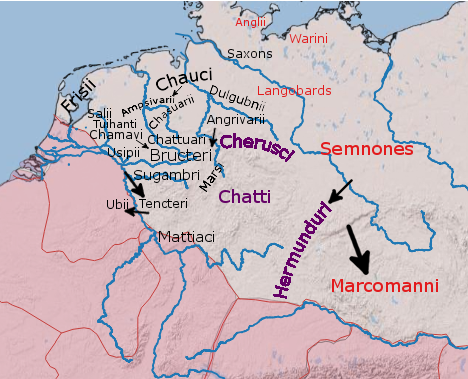|
Thorsberg
The Thorsberg moor (german: Thorsberger Moor, da, Thorsberg Mose or ''Thorsbjerg Mose'', South Jutlandic: ''Tosbarch'', ''Tåsbjerre'' "Thor's hill") near Süderbrarup in Anglia, Schleswig-Holstein, Germany, is a peat bog in which the Angles deposited votive offerings for approximately four centuries. It is the location of important Roman Iron Age finds, including early Elder Futhark runic inscriptions such as the Thorsberg chape, a Roman helmet, a shield buckle, and an early example of socks (attached to trousers). The finds are of similar importance as the contemporaneous finds from Illerup and Vimose in Denmark. Excavation The moor was excavated in 1858–1861 by a teacher from Flensburg, Helvig Conrad Engelhardt. The objects recovered by Engelhardt are on exhibit in the state museum of archaeology at Gottorf Castle; another 500 finds are on exhibit in the National Museum of Denmark in Copenhagen. Discoveries The deposits were made from approximately 100 BC to 500 AD ... [...More Info...] [...Related Items...] OR: [Wikipedia] [Google] [Baidu] |
Thorsberg Chape
The Thorsberg chape (a bronze piece belonging to a scabbard) is an archeological find from the Thorsberg moor, Germany, that appears to have been deposited as a votive offering.Tineke Looijenga, ''Texts & Contexts of the Oldest Runic Inscriptions'', Leyden/Boston: Brill, 2003, p. 259 It bears an Elder Futhark runic inscription, one of the earliest known, dating to roughly 200 CE. The artifact has been localized on archeological grounds to the region between the Rhine and the Elbe.Henrik Williams, "From Meldorf to Haithabu: Some Early Personal Names from Schleswig-Holstein," ''Von Thorsberg nach Schleswig'' pp. 149-66p. 157 The first element ''owlþu'', for ''wolþu-'', means "glory," "glorious one," cf. Old Norse ''Ullr'', Old English ''wuldor''. The second element, ''-þewaz'', means "slave, servant." The whole compound is a personal name or title, "servant of the glorious one" or "servant/priest of Ullr." On the reverse, ''ni-'' is the negative particle, ''waje-'' correspo ... [...More Info...] [...Related Items...] OR: [Wikipedia] [Google] [Baidu] |
Elder Futhark
The Elder Futhark (or Fuþark), also known as the Older Futhark, Old Futhark, or Germanic Futhark, is the oldest form of the runic alphabets. It was a writing system used by Germanic peoples for Northwest Germanic dialects in the Migration Period. Inscriptions are found on artifacts including jewelry, amulets, plateware, tools, and weapons, as well as runestones in Scandinavia, from the 2nd to the 10th centuries. In Scandinavia, beginning in the late 8th century, the script was simplified to the Younger Futhark, while the Anglo-Saxons and Frisians instead extended it, giving rise to the Anglo-Saxon futhorc. Both the Anglo-Saxon futhorc and the Younger Futhark remained in use during the Early and the High Middle Ages respectively, but knowledge of how to read the Elder Futhark was forgotten until 1865, when it was deciphered by Norwegian scholar Sophus Bugge. Description The Elder Futhark (named after the initial phoneme of the first six rune names: F, U, Þ, A, R and ... [...More Info...] [...Related Items...] OR: [Wikipedia] [Google] [Baidu] |
Runic Inscription
A runic inscription is an inscription made in one of the various runic alphabets. They generally contained practical information or memorials instead of magic or mythic stories. The body of runic inscriptions falls into the three categories of Elder Futhark (some 350 items, dating to between the 2nd and 8th centuries AD), Anglo-Frisian Futhorc (some 100 items, 5th to 11th centuries) and Younger Futhark (close to 6,000 items, 8th to 12th centuries). The total 350 known inscriptions in the Elder Futhark script fall into two main geographical categories, North Germanic (Scandinavian, c. 267 items) and Continental or South Germanic ( "German" and Gothic, c. 81 items). These inscriptions are on many types of loose objects, but the North Germanic tradition shows a preference for bracteates, while the South Germanic one has a preference for fibulae. The precise figures are debatable because some inscriptions are very short and/or illegible so that it is uncertain whether they qualify as ... [...More Info...] [...Related Items...] OR: [Wikipedia] [Google] [Baidu] |
Vimose
Finds from Vimose (), on the island of Funen, Denmark, include some of the oldest datable Elder Futhark runic inscriptions in early Proto-Norse or late Proto-Germanic from the 2nd to 3rd century in the Scandinavian Iron Age and were written in the time of the Roman Empire. *Vimose Comb (c. 160, considered the oldest known datable runic inscription altogether): harja (ᚺᚨᚱᛃᚨ) *Vimose Buckle (c. 200) aadagasu =? ansuz-a(n)dag-a(n)su / laasauwija =? la-a au-wija; *Vimose Chape Chape has had various meanings in English, but the predominant one is a protective fitting at the bottom of a scabbard or sheath for a sword or dagger (10 in the diagram). Historic blade weapons often had leather scabbards with metal fittings a ... (c. 250): mariha , , la / makija; possibly "Mari (the famous one) is the sword of Alla" *Vimose Woodplane (c. 300) talijo gisai oj: wiliz .a o ../ tkbis: hleuno: an regu * Vimose Sheathplate (c. 300): ; possibly "son/descendant of Awa" *Vimose Sp ... [...More Info...] [...Related Items...] OR: [Wikipedia] [Google] [Baidu] |
Süderbrarup
Süderbrarup ( da, Sønder Brarup) is a municipality in the district of Schleswig-Flensburg, in Schleswig-Holstein, Germany. It is situated on the north side of the Schlei, approx. 20 km northeast of Schleswig, and 30 km southeast of Flensburg. Süderbrarup is known for the Thorsberg moor archeological site. Süderbrarup is the seat of the ''Amt'' ("collective municipality") Süderbrarup. In March 2018 the former municipalities of Brebel and Dollrottfeld were merged into Süderbrarup. Events Brarupmarkt Heavily rooted in the German tradition of annual country fairs with rides (German: Jahrmarkt), Süderbrarup hosts the largest regional celebration of this kind in Schleswig-Holstein, drawing several hundred thousand visitors each year. Brarupmarkt has been an annual cornerstone of local culture since its inception in 1583. The commencement date for Brarupmarkt falls on the last complete weekend of July. Brarupmarkt traditions * Opening of Brarupmarkt by Mayor Friedr ... [...More Info...] [...Related Items...] OR: [Wikipedia] [Google] [Baidu] |
Angeln
Anglia ( German and Low German: ''Angeln''; Danish and South Jutlandic: ''Angel''; ang, Engla land) is a small peninsula on the eastern coast of Jutland (the Cimbric Peninsula). Jutland consists of the mainland of Denmark and the northernmost German state of Schleswig-Holstein. Anglia belongs to the region of Southern Schleswig, which constitutes the northern part of Schleswig-Holstein, and protrudes into the Bay of Kiel of the Baltic Sea. To the south, Anglia is separated from the neighbouring peninsula of Swania (Ger. ''Schwansen'', Dan. ''Svans'' or ''Svansø'') by the Sly Firth (Ger. ''Schlei'', Dan. ''Sli''), and to the north from the Danish peninsula of Sundeved (Ger. ''Sundewitt'') and the Danish island of Als (Ger. ''Alsen'') by the Flensburg Firth (Ger. ''Flensburger Förde'', Dan. ''Flensborg Fjord''). The landscape is hilly, dotted with numerous lakes. Whether ancient Anglia conformed to the borders of the Anglian Peninsula is uncertain. It may have ... [...More Info...] [...Related Items...] OR: [Wikipedia] [Google] [Baidu] |
Angles
The Angles ( ang, Ængle, ; la, Angli) were one of the main Germanic peoples who settled in Great Britain in the post-Roman period. They founded several kingdoms of the Heptarchy in Anglo-Saxon England. Their name is the root of the name ''England'' ("land of Ængle"). According to Tacitus, writing around 100 AD, a people known as Angles (Anglii) lived east of the Langobards and Semnones, who lived near the Elbe river. Etymology The name of the Angles may have been first recorded in Latinised form, as ''Anglii'', in the ''Germania'' of Tacitus. It is thought to derive from the name of the area they originally inhabited, the Anglia Peninsula (''Angeln'' in modern German, ''Angel'' in Danish). Multiple theories concerning the etymology of the name have been hypothesised: # According to Gesta Danorum Dan and Angul (Angel) were made rulers by the consent of their people because of their bravery. Dan gave name to Danes and Angel gave names to Angles. # It originated fro ... [...More Info...] [...Related Items...] OR: [Wikipedia] [Google] [Baidu] |
Helvig Conrad Engelhardt
Helvig may refer to: *Helvig of Schauenburg (1398–1436), duchess of Schleswig *Helvig of Schleswig Helvig of Schleswig (also erroneously Hedwig; 1320–1374) was the queen of Denmark as the spouse of King Valdemar IV. She was the mother of Queen Margaret I of Denmark. Life Helvig was the daughter of Eric II, Duke of Schleswig, and Adelai ... (died 1374), Danish queen consort People with the surname * Amalia von Helvig (1776–1831), German-Swedish artist and writer * Christoph Helvig (1581–1617), German chronologist and historian See also * Helwig * Hellwig {{disambiguation, name, surname ... [...More Info...] [...Related Items...] OR: [Wikipedia] [Google] [Baidu] |
Herbert Schutz
Herbert (Herb) Schutz (February 25, 1937 – January 1, 2018) was a German-born Canadian philologist who was Professor Emeritus and Chair of the Department of Germanic and Slavic Studies/Modern Languages, Literatures and Cultures at Brock University. Biography Herbert Schutz was born in Germany on February 25, 1937. He emigrated to Canada in 1951. Schutz graduated from the Central Technical School in Toronto in 1956. Schutz obtained his BA from the University of Toronto in 1959, where he studied Ancient, Near Eastern, and Modern History. Obtaining his teaching qualifications at the Ontario College of Education, Schutz taught at Jarvis Collegiate Institute and Central Technical School, where he was head of the French department and as assistant head of Moderns. Obtaining his MA (1965) and PhD (1968) at the University of Toronto, Schutz taught at Brock University, where he became Professor in 1983. He subsequently served as Chairman of the Department of Germanic and Slavic Studi ... [...More Info...] [...Related Items...] OR: [Wikipedia] [Google] [Baidu] |




